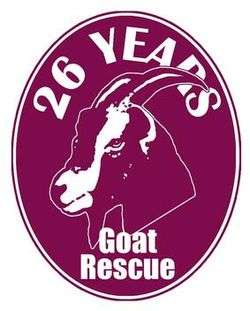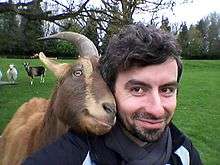Buttercups Sanctuary for Goats
The Buttercups Sanctuary for Goats is a British charitable organisation devoted to goat welfare. The charity, which is based in Maidstone, Kent, England, was established in 2003. It is the only goat charity in the whole of the UK.
 | |
| Founded | 2003 |
|---|---|
| Founder | Bob and Valerie Hitch |
| Focus | Animal Welfare |
| Location |
|
Area served | Kent and the surrounding counties |
| Method | animal sanctuaries, popular education, Adult education |
| Website | Buttercups Sanctuary for Goats |
History
The Buttercups Sanctuary started in 1989 when Robert and Valerie Hitch took over the care of two goats from the RSPCA. As more goats arrived, having become unwanted or been neglected, the costs of keeping them soared, so they were granted charity status by the Charity Commission for England and Wales in September 2003.
Animal welfare

The sanctuary now cares for over 140 goats and provides care to approximately an additional 120 goats in foster homes.[1]
Common problems for goats arriving at the sanctuary include malnutrition and ailments such as rainscald, foot rot, mud fever and other skin conditions. They may also be infested with worms. Neglect and cruelty may also mean, that on arrival, the animals may be very mistrustful of humans. Yet, many do recover human trust again.[2]
Educational work
The sanctuary offers student work-placements to assist with their studies.
Postdoctoral researchers from Queen Mary University used this sanctuary to conduct studies into Anthrozoology[3]
Some of this research work has been featured on prime-time British television.[4]
See also
References
- Cole, Angela (4 April 2014). "Buttercups Goat Sanctuary in Boughton Monchelsea, Maidstone, needs foster homes for its four-legged rescues". Kent Online. Kent, England, UK: KM Group. Retrieved 30 August 2016.
- McElligott, Alan (April 2013). "Happy goats: How animal rehab works". BBC YouTube channel. BBC. Retrieved 31 August 2016.
- Nawroth, Christian; Brett, Jemma; McElligott, Alan (5 July 2016), "Goats display audience-dependent human-directed gazing behaviour in a problem-solving task", Biology Letters, 12 (7): 20160283, doi:10.1098/rsbl.2016.0283, PMC 4971169, PMID 27381884
- Bradbury, Julia (11 March 2012). "Goats on Countryfile". Countryfile. BBC. Retrieved 31 August 2016.